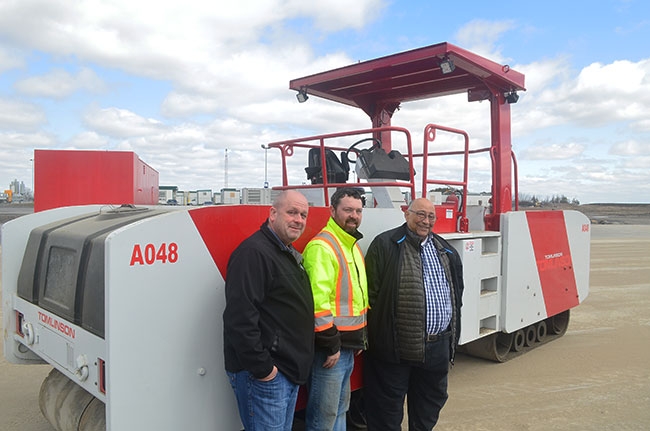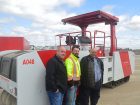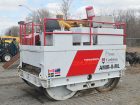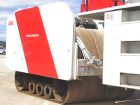
Features
Roads & Paving
Technology
Pothole-free pavement?
Lifetime of research leads to innovative new roller kit
June 4, 2018 By Andrew Snook

June 4, 2018 – Since the construction of the first roads, potholes have plagued road infrastructure around the world, and people have been trying to find ways to make them disappear. So when I first heard about a revolutionary compaction technology designed by Carleton University’s director of the Infrastructure Protection and International Security Master’s Program, Dr. A.O. Abd El Halim (“Halim” to his friends and colleagues), I was extremely excited to meet the man and his technology.
I drove to the Ottawa area to meet the man behind the technology at a pub in Gloucester, Ont. Shortly after I arrived and we exchanged pleasantries, a waitress came to take our order. Halim asked her for two raw eggs in a dish – a strange lunch order, I thought. He quickly explained that the eggs were not for eating, but for an experiment that required my participation. When the eggs arrived, Halim asked me to take a butter knife and begin tapping the top of the egg gently inside the dish. I tapped the egg until cracks began to form at the top.
Halim then handed me the second egg and asked me tap it gently in the same spot as the first one, but this time with my fingertip. I tapped several times and nothing happened. He then asked me to tap harder, so I did. Nothing happened. He asked me to tap it harder a third time, at which point the egg slipped loose from my other hand, bounced off Halim (as I watched in horror), then fell to the floor and broke.
“I’m so sorry,” I said to both Halim and the waitress that came by to clean the mess.
“That’s alright,” Halim replied. “Did you see how the egg cracked when the metal tapped it? And how it didn’t crack with your finger? This is basically how my technology works.”
Back in the mid-1980’s, Halim invented a rubber-belted asphalt compactor that was designed to compact without leaving the small cracks in the roads that were being left by some traditional steel and rubber rollers. The idea behind the technology was that the softer, rubber-belted compactor could sit on a section of asphalt for a longer duration of time while exerting lower pressure than traditional rollers, and this would allow for longer continuous contact with the asphalt that would produce crack-free asphalt pavement during the compaction process. He named his compactor “AMIR” after his son.
AMIR I and HIPAC
The first version of the paver (AMIR) was a non-motorized, single-belt system. It was developed and field-tested in Egypt in the mid-80s through financial assistance from the Canadian and Egyptian governments. The Egyptian AMIR motivated National Research Council Canada (NRC) and Toronto-based Lovat Tunnel Equipment Inc. to join Carleton University and Halim to build the first motorized (AMIR I). Approximately a dozen field tests were performed on the machine, compacting layers of sand, as well as asphalt layers. Newspapers and magazines around the world showcased his technology through the mid-80s and into the 1990s, calling it revolutionary to the industry. Halim tried to get it licensed and manufactured by several OEMs, but contract negotiations were unsuccessful.
But in 1996 an Australian contractor named Pioneer Road Services Pty Ltd. decided to have Halim’s compactor shipped to them for further development. The company invested approximately $750,000 into the technology, and developed a dual-belted version of the compactor. This version of the machine was 1.6-metres wide and 12.5-metres long and weighed 16 tonnes. This version would come to be known as the HIPAC compactor; the second generation of AMIR. The company was planning on using the technology during the construction of roads for the 2000 Summer Olympics.
“They used it to construct a road leading from the Sydney airport to the Olympic Village, and continued to use it for several years,” Halim says.
Despite successful field tests over the years in Egypt, Australia and Canada, negotiations continued to be unsuccessful with various OEMs to try and get the compactor manufactured. After decades of hard work on the technology without getting a contract ironed out with a manufacturer that met Halim’s expectations, he decided to put the project on hold and placed the AMIR I compactor in storage and focused on his other research and work as a professor at Carleton University.
Getting the call-up
The AMIR-I compactor sat collecting dust until Halim received a surprise phone call in 2009, while preparing one of his students for a presentation at an educational conference.
“I got a call in Quebec City from a friend that said, ‘The MTO (Ministry of Transportation of Ontario) needs your roller, can you present about it?’” Halim recalls. “I went to Kingston and gave a presentation. It took two years but the MTO were very kind. They gave me budget… I had a chance to prove its functionality. The MTO started to give up on asphalt on roads and [in some cases] were replacing it with concrete.”
The research budget was used to add engineering capabilities and mechanical improvements, which produced AMIR II.
“MTO has contributed to the project in several ways,” says Don Rowat, head of quality assurance with the Ontario Ministry of Transportation Operations’ Eastern Region. “Research funding has been provided to Carleton University through the Highway Infrastructure Innovations Funding Program (HIIFP) and also by direct assignment of research grants. Theory has to be put into practice and the MTO has been there for the incremental developments and provided our highways for real-life test sections.”
The first field tests of the AMIR II in Ontario took place in 2011. They did not go according to plan. Two contractors that were selected by the MTO to field test the equipment were unable to successfully use the technology. Fortunately, Russ Perry, vice-president of Ottawa-based Tomlinson Group’s heavy civil division, saw the potential of the technology and decided to take on the project with a significant investment from his company in 2012.
“He’s a very progressive engineer,” Halim adds. “They have a mechanic that is a genius (Stewart Allen).”
TRAK changes
When coming up with a name for the new prototype of the final commercial version of AMIR technology, Halim and the Tomlinson Group decided to call it TRAK, an acronym short for “Tomlinson-Russ-Amir-Kit.”
The first drastic change that was required on the existing AMIR-II compactor was an idea brought up to Halim by his father-in-law (Mr. Ingram), who was a highway contractor in Calgary – during a conversation about his struggles to get an OEM on board.
“He told me nobody will buy my compactor,” Halim recalls, adding that the cost to replace a company’s rollers fleet would be too expensive.
This generated an idea that totally changed the way Halim looked at his compactor. Instead of trying to sell a new compactor to the industry, why not just sell the rollers as a kit? Halim, Perry and Allen all worked on developing a roller kit that uses the AMIR-II paving technology but could be retrofitted to just about any existing compactor on the market.
“We wanted to make sure that if we built it, it was multi-purpose,” Perry says. “We’ve got 20 existing rollers, ourselves. We don’t want to scrap them – no one will.”
By focusing on developing a retrofitted roller kit instead of a brand-new compactor, Perry was able to solve some of the biggest challenges that plagued the AMIR-II prototype: manoeuvrability and training employees to use the machine.
“We needed a system that would keep the belts aligned so we developed a track with lugs similar to a paver or bulldozer that allowed the track to run smoothly and stay in place,” Perry explains. “We also needed a better system for tensioning the belts so we adapted technology from other tracked equipment to ensure we had proper tension, which ensured adequate traction that eliminated slippage when engaging the drives. The last issue was developing a set of tracks wide enough to provide similar coverage as the existing machines so this kit could be interchanged with drums so that contractors could save on having to buy additional machines.”
The AMIR-II was difficult to steer and required advanced knowledge of how the machine functioned. This was highly impractical in the field. By equipping an existing paver that can use a 60” to 66” compactor – in this case, a CAT 534B – anyone with experience and proper training using a compactor can operate the new prototype.
“The former model was far more complicated, you basically needed to be a rocket scientist to drive it,” Perry says.
Halim praises Perry for having the practical experience and knowledge that he lacked when developing the first prototypes.
“A lot of the things Russ saw, I didn’t see,” Halim says. “This is the difference between a researcher and a user.”
Another design issue addressed by using existing compactors were the paving issues experienced by the AMIR-II when working around curbs.
“The old machine had no guidance system,” Perry says, adding that the belts had a tendency of coming off the track when dealing with superelevation. “The belt itself has lugs down the centre track so the track is contained, so it can’t come off anymore.”
Another issue that needed to be addressed on the prototype was working with additives and polymers that make asphalt mixes stickier – an issue that didn’t need to be addressed when the original prototype was built. To help solve this issue, Tomlinson worked with an oil company in Hamilton to create different types of non-oil based lubricators that can prevent the asphalt from sticking to the belts (due to the patent-pending process, additional information about the lubrication could not be disclosed at this time).
Big returns
The MTO see a huge potential for savings if the technology reaches its full potential.
“MTO’s main driver for funding the project was evaluating a revolutionary technology that could potentially extend the life of asphalt pavements and save significant taxpayer dollars. MTO was also interested in determining if the technology could produce a low permeability asphalt surface on bridge decks to help reduce the ingress of chlorides into the concrete and lengthen the service life of the structure,” Rowat says. “With the capabilities of the new third-generation AMIR equipment, MTO hopes to construct asphalt pavements with lower permeability on larger projects, not just bridge decks. If the permeability of the pavement is lower, the damaging effects of water will be reduced and the pavements will last longer.
“The new third-generation ‘AMIR III’ was recently used (in November 2017) to construct a test section on Didsbury Rd. in Ottawa, in partnership with the City of Ottawa. The AMIR III was tested in a side-by-side comparison with the most modern asphalt compaction equipment available in the marketplace and the results are very impressive. The AMIR III produced a superior quality product, which is clearly visible and measurable in terms of lower permeability, which is critical for the next step, writing the specifications for use in future trial contracts. The compaction using the AMIR III is equal to or better than conventional equipment and the AMIR III does not produce cracks in the asphalt.”
Rowat says that even a slight increase in the lifetime of asphalt pavements would produce significant savings for the province.
“A 2016 analysis indicated that if asphalt pavements on MTO’s highways could last even one year longer, the province would save, on average, $50 million annually,” he says.
Tomlinson invested about $500,000 in developing the new roller kit prototype. The company believes there is potential for the technology to reduce the amount of equipment and number of operators needed on a jobsite. One compactor with the new roller equipped could replace three rollers in a train for certain applications; reducing the number of drivers required, Halim says. “At present, the industry uses three different rollers, which typically need between 20 to 26 passes, our roller needs only six to eight passes.”
“We’re hoping, by adapting the rollers [further], to change that to four passes,” Perry adds.
Retrofitting the roller kit onto an existing compactor currently takes between four and five days. After the retrofit is completed, it takes one day to swap out the prototype for another type of roller.
In addition to road paving applications, Halim says there is potential for the roller kit to be used on airport runway new construction and rehabilitation projects, if the roller was manufactured a little wider than the existing prototype.
If all goes as planned, Tomlinson could soon see labour and maintenance costs in its paving division decrease substantially in the future – and with lower operating costs comes more competitive bidding for future jobs. And if that happens, you’ll likely be seeing roller kits inspired by Halim’s work on a lot of jobsites in the future; a nice send-off for a man soon to retire, who dedicated a lifetime of research to improving road infrastructure around the world. Enjoy your retirement, Halim. May your future journeys on the road of life be pothole-free.
*Halim acknowledges the continuous financial support of The Natural Sciences and Engineering Research Council of Canada in supporting his research.
Print this page



